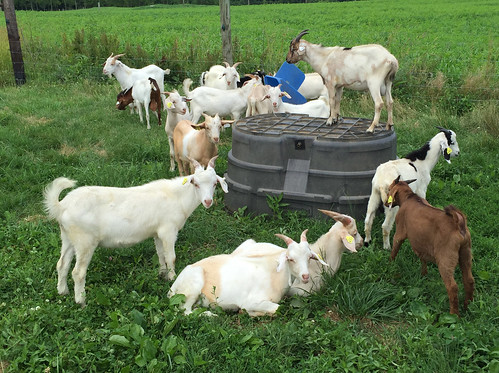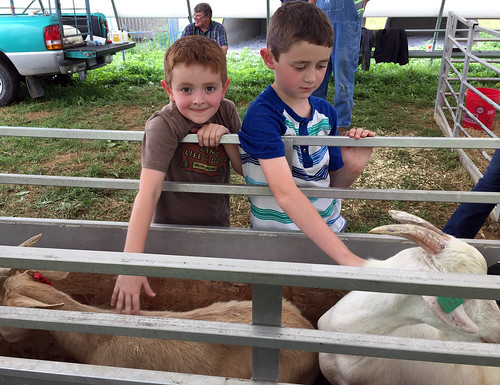Ninety-seven (97) bucks were delivered to the test site on June 23 and 24. Delivery weights ranged from 32.6 to 79.2 lbs. and averaged 47.6 + 9.1 lbs. Nineteen bucks (19.6 percent) failed to meet the minimum weight requirements (of 40 lbs). Four were below 35 lbs. Three exceeded the maximum weight requirement (of 70 lbs). The median weight was 45.8 lbs.
Upon arrival, all goats were sequentially dewormed with albendazole (Valbazen® @ 2 ml/25 lb), moxidectin (Cydectin® @ 4.5 ml/25 lb) and levamisole (Prohibit® @ 3 ml of concentrated drench per 50 lbs). FAMACHA© scores ranged from 1 to 5 and averaged 1.9 + 0.8. The median FAMACHA© score was 2. Only three goats had FAMACHA© scores > 4.
In the future, goats with FAMACHA© scores of 1 and 2 will not be dewormed, whereas goats with FAMACHA© scores of 4 or 5 will be dewormed. Goats with FAMACHA© scores of 3 may or not be dewormed, depending upon the criteria of the Five Point Check© and other factors, such as fecal egg count (2 weeks ago), weight loss (> 0.1 lbs), percent of FAMACHA© 4s and 5s (in herd), and trends in scoring.
In addition to FAMACHA© score (#1), the Five Point Check© includes jaw (#2, bottle jaw), back (#3, body condition score), tail (#4, dag score), and coat condition (#5). Upon arrival and every two weeks, the goats will be evaluated for these criteria.
Upon arrival, no goat had bottle jaw. In the test, a scale of 1 to 5 is used to assess body condition. 1 is an emaciated goat, whereas 5 is an obese goat. A score of 2.5 represents an average body condition score. Body condition scores ranged from 1.5 to 3.0 and averaged 2.2 + 0.3. The median body condition score was 2.
The condition of a goat's hair coat can be indicative of its overall health and thriftiness. Coat condition scores range from 1 to 3, with 1 representing a poor quality hair coat , 2 being average, and 3 being a shiny, smooth hair coat. Coat condition scores ranged from 1.5 to 2.5 and averaged 2.1. The median score was 2.
Dags is originally a sheep term, literally meaning the matted wool on the sheep's backside, usually due to diarrhea (scours). In goats, we look for fecal soiling on the tail, legs, and hocks. Scores range from 0 to 5, with 0 representing no fecal soiling and 5 representing a completed covered backside (very nasty!). Dag scores ranged from 0 to 1. The median score was 0. Most backsides were clean and free from fecal soiling.
Because the dag score is not always indicative of current scouring, we also evaluate fecal consistency. A fecal consistency score of 1 represents normal fecal pellets, whereas a score of 4 is liquid feces (diarrhea). Fecal consistency scores ranged from 1 to 3 and averaged 1.1 + 0.4. The median score was 1. Only a few goats had scours. We tend to see scours in the goats as their diets change, as we rotate them among different paddocks and forage-types. Rainfall will also have a big effect on fecal consistency.
Fecal samples (2-4 g) were obtained from the rectum of each goat. Samples were not obtained from six goats. Once the test starts, two attempts will be made to obtain a fecal sample from an individual goat. If there is no fecal sample when the goat is scored, it will be recycled through the handling system and a second attempt will be made.
Fecal egg counts are a measure of parasite resistance. They will be determined for each goat on a bi-weekly basis. The fecal egg counts from June 23-24 will be compared to the July 7 fecal egg counts to determine the effectiveness of the sequential deworming. A successful treatment will have reduced worm egg counts by 95 percent or more. The purpose of the sequential deworming is to equalize the goats by reducing their fecal egg counts to (near) zero. This way differences observed in the test can be attributed to genetics, not environment.
A pooled fecal sampled was collected from random goats. The eggs in the sample will be hatched into larvae to determine which species of worms were present in the goats upon arrival. While tapeworm eggs and coccidia oocysts can be differentiated from roundworm (strongyle-type) eggs, it is not possible to differentiate between the eggs of the barber pole worm (Haemonchus contortus) and the "bankrupt worms" (Tricholostrongyles and Teladorsagia). Fecal egg counts and larvae ID will be done by Dr. Dahlia O'Brien's lab at Virginia State University.
In addition to the weighing, scoring, and deworming, the goats were made to stand in a footbath containing zinc sulfate. The purpose of foot soaking is to prevent hoof problems. An test ear tag was inserted into the ear of each goat, opposite to ear with the scrapie tag. The goats were vaccinated for soremouth (in the ear). In the early part of the test, they will be treated for coccidiosis (in the water). Barley will be introduced gradually as a supplement. Starting weights will be determined on July 7 and 8.
Download June 24 Report
Upon arrival, all goats were sequentially dewormed with albendazole (Valbazen® @ 2 ml/25 lb), moxidectin (Cydectin® @ 4.5 ml/25 lb) and levamisole (Prohibit® @ 3 ml of concentrated drench per 50 lbs). FAMACHA© scores ranged from 1 to 5 and averaged 1.9 + 0.8. The median FAMACHA© score was 2. Only three goats had FAMACHA© scores > 4.
 |
| Some of the bucks |
In the future, goats with FAMACHA© scores of 1 and 2 will not be dewormed, whereas goats with FAMACHA© scores of 4 or 5 will be dewormed. Goats with FAMACHA© scores of 3 may or not be dewormed, depending upon the criteria of the Five Point Check© and other factors, such as fecal egg count (2 weeks ago), weight loss (> 0.1 lbs), percent of FAMACHA© 4s and 5s (in herd), and trends in scoring.
In addition to FAMACHA© score (#1), the Five Point Check© includes jaw (#2, bottle jaw), back (#3, body condition score), tail (#4, dag score), and coat condition (#5). Upon arrival and every two weeks, the goats will be evaluated for these criteria.
Upon arrival, no goat had bottle jaw. In the test, a scale of 1 to 5 is used to assess body condition. 1 is an emaciated goat, whereas 5 is an obese goat. A score of 2.5 represents an average body condition score. Body condition scores ranged from 1.5 to 3.0 and averaged 2.2 + 0.3. The median body condition score was 2.
 |
| The working system |
The condition of a goat's hair coat can be indicative of its overall health and thriftiness. Coat condition scores range from 1 to 3, with 1 representing a poor quality hair coat , 2 being average, and 3 being a shiny, smooth hair coat. Coat condition scores ranged from 1.5 to 2.5 and averaged 2.1. The median score was 2.
Dags is originally a sheep term, literally meaning the matted wool on the sheep's backside, usually due to diarrhea (scours). In goats, we look for fecal soiling on the tail, legs, and hocks. Scores range from 0 to 5, with 0 representing no fecal soiling and 5 representing a completed covered backside (very nasty!). Dag scores ranged from 0 to 1. The median score was 0. Most backsides were clean and free from fecal soiling.
Because the dag score is not always indicative of current scouring, we also evaluate fecal consistency. A fecal consistency score of 1 represents normal fecal pellets, whereas a score of 4 is liquid feces (diarrhea). Fecal consistency scores ranged from 1 to 3 and averaged 1.1 + 0.4. The median score was 1. Only a few goats had scours. We tend to see scours in the goats as their diets change, as we rotate them among different paddocks and forage-types. Rainfall will also have a big effect on fecal consistency.
 |
| Kiko talk |
Fecal samples (2-4 g) were obtained from the rectum of each goat. Samples were not obtained from six goats. Once the test starts, two attempts will be made to obtain a fecal sample from an individual goat. If there is no fecal sample when the goat is scored, it will be recycled through the handling system and a second attempt will be made.
Fecal egg counts are a measure of parasite resistance. They will be determined for each goat on a bi-weekly basis. The fecal egg counts from June 23-24 will be compared to the July 7 fecal egg counts to determine the effectiveness of the sequential deworming. A successful treatment will have reduced worm egg counts by 95 percent or more. The purpose of the sequential deworming is to equalize the goats by reducing their fecal egg counts to (near) zero. This way differences observed in the test can be attributed to genetics, not environment.
 |
| Future consigners |
A pooled fecal sampled was collected from random goats. The eggs in the sample will be hatched into larvae to determine which species of worms were present in the goats upon arrival. While tapeworm eggs and coccidia oocysts can be differentiated from roundworm (strongyle-type) eggs, it is not possible to differentiate between the eggs of the barber pole worm (Haemonchus contortus) and the "bankrupt worms" (Tricholostrongyles and Teladorsagia). Fecal egg counts and larvae ID will be done by Dr. Dahlia O'Brien's lab at Virginia State University.
In addition to the weighing, scoring, and deworming, the goats were made to stand in a footbath containing zinc sulfate. The purpose of foot soaking is to prevent hoof problems. An test ear tag was inserted into the ear of each goat, opposite to ear with the scrapie tag. The goats were vaccinated for soremouth (in the ear). In the early part of the test, they will be treated for coccidiosis (in the water). Barley will be introduced gradually as a supplement. Starting weights will be determined on July 7 and 8.
Download June 24 Report











